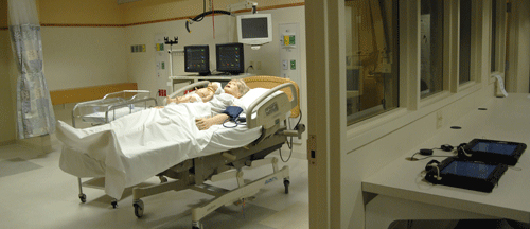Simulation center serves as virtual hospital

Imagine a seven-room hospital, where doctors gain a firm foundation in surgical techniques, hand-to-eye coordination and repetitive skills exercises—before they pick up a scalpel to operate on a real patient.
At Christiana Care Health System’s Virtual Education & Simulation Training Center, babies are born every day, just as they are in a real hospital. Adults and children are rushed to the emergency department with injuries suffered in accidents. Patients are intubated, have their blood drawn and get IV drips.
Birthing manikin Noelle in the new Labor & Delivery room at Christiana Care’s Virtual Education and Simulation Training Center.
The Virtual Education & Simulation Training Center is outfitted to function like a hospital, complete with a trauma bay, intensive care unit, operating room and standardized patient rooms.
The center is one of only 106 member medical simulation centers in the U.S., according to the Society for Simulation in Health Care.
But the patients are manikins, adult and pediatric high-fidelity human patient simulators that breathe, speak, blink their eyes and respond to stimuli. Controlled by computers to simulate various conditions, the manikins produce heartbeats, bowel sounds and blood pressure readings.
“We have an obligation to our community, our families and ourselves to provide a training environment that does not compromise patient safety,” says Glen Tinkoff, M.D., medical director, Virtual Education & Simulation Training Center. “Previously, the only way we could teach these skills was at the bedside.”
Doctors gain crucial experience dealing with high-risk conditions that rarely occur so they can provide the best care when those situations do arise. Audio and visual recordings enable learners to review and analyze their work.
“The Virtual Education & Simulation Training Center provides the most up-to-date education facilities for physicians, as well as residents, medical students, nurses and allied health care personnel and staff,” says Brian Little, M.D., Ph.D., vice president for Academic Affairs and Research. “Medical schools, postgraduate training programs, credentialing committees and licensing and specialty boards are all placing greater emphasis on using simulation modalities to evaluate competence.”
The facility has received certification as a Level II Educational Institute by the American College of Surgery, a designation for providers of basic education in enhancing patient safety through simulation.
The 9,000-square-foot center is equipped with a working laparoscopy station with simulated tissues, an endoscopy/bronchoscopy simulator, 3D visualization software and display, with more than 100 task trainers.
Photo Gallery: Virtual Education and Simulation Training Center
Error fetching Flickr photos: A feed could not be found at `https://api.flickr.com/services/feeds/photoset.gne?lang=en-us&format=feed-rss_200&nsid=28142983@N07&set=72157622327379577&per_page=50`; the status code is `404` and content-type is `text/html; charset=UTF-8`